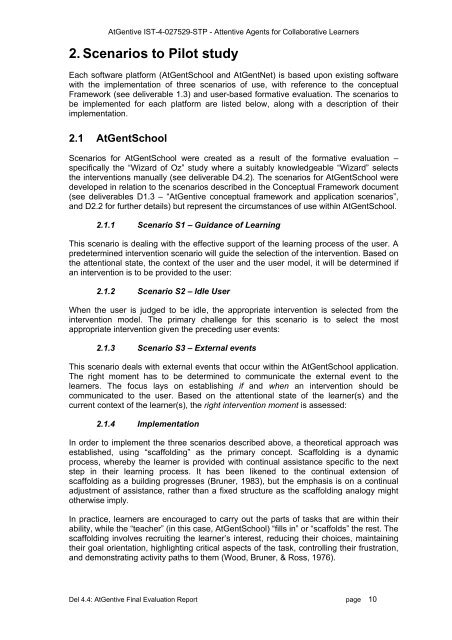Deliverable 4.4 - INSEAD CALT
Deliverable 4.4 - INSEAD CALT
Deliverable 4.4 - INSEAD CALT
You also want an ePaper? Increase the reach of your titles
YUMPU automatically turns print PDFs into web optimized ePapers that Google loves.
AtGentive IST-4-027529-STP - Attentive Agents for Collaborative Learners2. Scenarios to Pilot studyEach software platform (AtGentSchool and AtGentNet) is based upon existing softwarewith the implementation of three scenarios of use, with reference to the conceptualFramework (see deliverable 1.3) and user-based formative evaluation. The scenarios tobe implemented for each platform are listed below, along with a description of theirimplementation.2.1 AtGentSchoolScenarios for AtGentSchool were created as a result of the formative evaluation –specifically the “Wizard of Oz” study where a suitably knowledgeable “Wizard” selectsthe interventions manually (see deliverable D4.2). The scenarios for AtGentSchool weredeveloped in relation to the scenarios described in the Conceptual Framework document(see deliverables D1.3 – “AtGentive conceptual framework and application scenarios”,and D2.2 for further details) but represent the circumstances of use within AtGentSchool.2.1.1 Scenario S1 – Guidance of LearningThis scenario is dealing with the effective support of the learning process of the user. Apredetermined intervention scenario will guide the selection of the intervention. Based onthe attentional state, the context of the user and the user model, it will be determined ifan intervention is to be provided to the user:2.1.2 Scenario S2 – Idle UserWhen the user is judged to be idle, the appropriate intervention is selected from theintervention model. The primary challenge for this scenario is to select the mostappropriate intervention given the preceding user events:2.1.3 Scenario S3 – External eventsThis scenario deals with external events that occur within the AtGentSchool application.The right moment has to be determined to communicate the external event to thelearners. The focus lays on establishing if and when an intervention should becommunicated to the user. Based on the attentional state of the learner(s) and thecurrent context of the learner(s), the right intervention moment is assessed:2.1.4 ImplementationIn order to implement the three scenarios described above, a theoretical approach wasestablished, using “scaffolding” as the primary concept. Scaffolding is a dynamicprocess, whereby the learner is provided with continual assistance specific to the nextstep in their learning process. It has been likened to the continual extension ofscaffolding as a building progresses (Bruner, 1983), but the emphasis is on a continualadjustment of assistance, rather than a fixed structure as the scaffolding analogy mightotherwise imply.In practice, learners are encouraged to carry out the parts of tasks that are within theirability, while the “teacher” (in this case, AtGentSchool) “fills in” or “scaffolds” the rest. Thescaffolding involves recruiting the learner’s interest, reducing their choices, maintainingtheir goal orientation, highlighting critical aspects of the task, controlling their frustration,and demonstrating activity paths to them (Wood, Bruner, & Ross, 1976).Del <strong>4.4</strong>: AtGentive Final Evaluation Report page 10
















